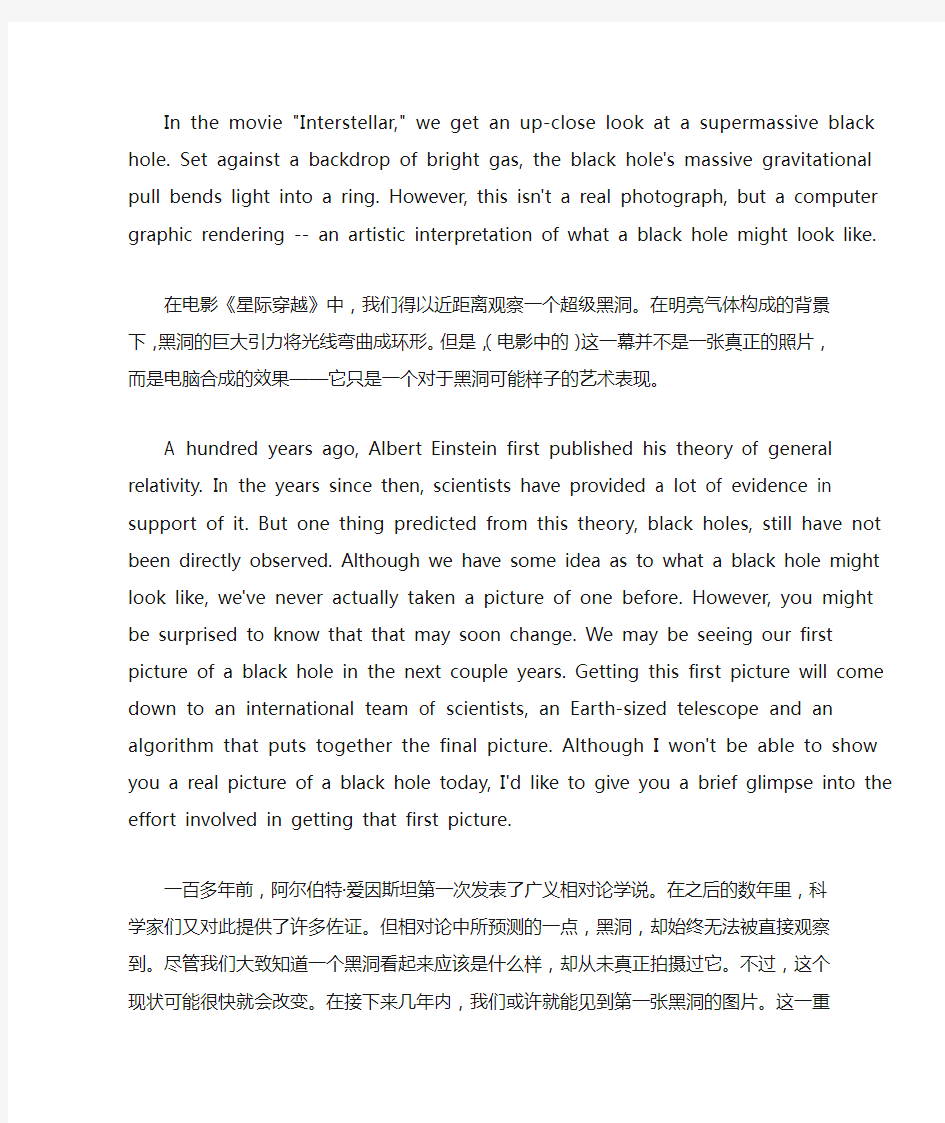探索黑洞 中英文演讲

- 1、下载文档前请自行甄别文档内容的完整性,平台不提供额外的编辑、内容补充、找答案等附加服务。
- 2、"仅部分预览"的文档,不可在线预览部分如存在完整性等问题,可反馈申请退款(可完整预览的文档不适用该条件!)。
- 3、如文档侵犯您的权益,请联系客服反馈,我们会尽快为您处理(人工客服工作时间:9:00-18:30)。
In the movie "Interstellar," we get an up-close look at a supermassive black hole. Set against a backdrop of bright gas, the black hole's massive gravitational pull bends light into a ring. However, this isn't a real photograph, but a computer graphic rendering -- an artistic interpretation of what a black hole might look like.
在电影《星际穿越》中,我们得以近距离观察一个超级黑洞。在明亮气体构成的背景下,黑洞的巨大引力将光线弯曲成环形。但是,(电影中的)这一幕并不是一张真正的照片,而是电脑合成的效果——它只是一个对于黑洞可能样子的艺术表现。
A hundred years ago, Albert Einstein first published his theory of general relativity. In the years since then, scientists have provided a lot of evidence in support of it. But one thing predicted from this theory, black holes, still have not been directly observed. Although we have some idea as to what a black hole might look like, we've never actually taken a picture of one before. However, you might be surprised to know that that may soon change. We may be seeing our first picture of a black hole in the next couple years. Getting this first picture will come down to an international team of scientists, an Earth-sized telescope and an algorithm that puts together the final picture. Although I won't be able to show you a real picture of a black hole today, I'd like to give you a brief glimpse into the effort involved in getting that first picture.
一百多年前,阿尔伯特·爱因斯坦第一次发表了广义相对论学说。在之后的数年里,科学家们又对此提供了许多佐证。但相对论中所预测的一点,黑洞,却始终无法被直接观察到。尽管我们大致知道一个黑洞看起来应该是什么样,却从未真正拍摄过它。不过,这个现状可能很快就会改变。在接下来几年内,我们或许就能见到第一张黑洞的图片。这一重任会落在一个由各国科学家组成的团队上,同时需要一个地球大小的天文望远镜,以及一个可以让我们合成出最终图片的算法。尽管今天我不能让你们见到真正的黑洞图片,我还是想让你们大致了解一下得到第一张(黑洞)图片所需要的努力。
My name is Katie Bouman, and I'm a PhD student at MIT. I do research in a computer science lab that works on making computers see through images and video. But although I'm not an astronomer, today I'd like to show you how I've been able to contribute to this exciting project.
我叫凯蒂·伯曼,是麻省理工学院的一名博士生。我在计算机科学实验室中进行让电脑解析图片和视频信息的研究。尽管我并不是个天文学家,今天我还是想向大家展示我是怎样在这个项目中贡献自己的一份力量的。
If you go out past the bright city lights tonight, you may just be lucky enough to see a stunning view of the Milky Way Galaxy. And if you could zoom past millions of stars, 26,000 light-years toward the heart of the spiraling Milky Way, we'd eventually reach a cluster of stars right at the center. Peering past all the galactic dust with infrared telescopes, astronomers have watched these stars for over 16 years. But it's what they don't see that is the most spectacular. These stars seem to orbit an invisible object. By tracking the paths of these stars, astronomers have concluded that the only thing small and heavy enough to cause this motion is a supermassive black hole -- an object so dense that it sucks up anything that ventures too close -- even light.
